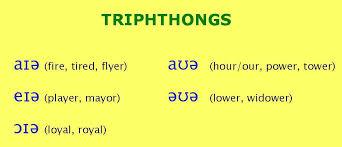Phonetics
| Site: | Plateforme pédagogique de l'Université Sétif2 |
| Cours: | phonetics |
| Livre: | Phonetics |
| Imprimé par: | Visiteur anonyme |
| Date: | lundi 20 octobre 2025, 04:25 |
Description
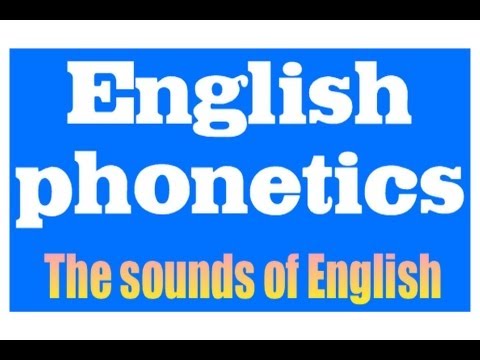
1. Speech Sounds
Speech sounds in English are of two different types: Vowels and Consonants.
2. Consonants
Consonants are of different types
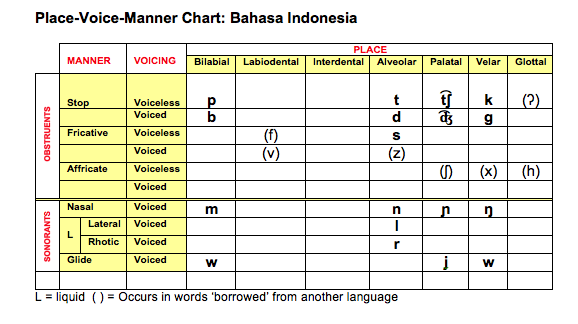
2.1. Plosives
Perhaps plosives are the easiest sounds to teach and learn in an
Plosives are defined as consonant sounds whichinvolve, first, a stricture of the mouth that allows no air to escape from the vocaltract and, second, the compression and release of the air. So, there are fourphases in the production of plosives: closure, hold, release and post-release. English has six plosive consonants, p, t, k, b, d, g. /p/ and /b/ are bilabial,that is, the lips are pressed together. /t/ and /d/ are alveolar, so the tongue ispressed against the alveolar ridge. /k/ and /g/ are velar; the back of the tongueis pressed against an intermediate area between the hard and the soft palate.
/p/, /t/ and /k/ are voiceless. /b/, /d/ and /g/ are normally voiced. Therelease of the voiceless plosives is followed by audible plosion and, in the postreleasephase, by an aspiration. So, the most noticeable difference between thevoiceless and the voiced plosives is this aspiration. In VC position, the vowelspreceding the voiceless plosives are much shorter.
Place of articulation
Bilabialal veolar Velar
Voiceless p t K
Voiced b d G
– a plosive is a consonant characterized by a complete obstruction of the outgoing airstream by the articulators, a build up of air pressure in the mouth, and finally a release of that pressure. A stop is merely the first part of this sound (the stopping of the airstream). In other words, in producing these sounds, the air is stopped for a brief moment (say pop over and over and pay attention to what’s happening). There are three types of plosive in English. For an interactive example of each sound (including descriptive animation and video), click this link, then in the window that opens, click stops, and select the appropriate sound.
/p/ /b/ bilabial plosives
A bilabial (from bi- two and labia lip) plosive is a sound in which the flow of air out of the body is interrupted by closing the lips together. English has two bilabial plosives — /p/ in which the vocal chords are not used (voiceless) as in pizza and pepper, and /b/ in which they are used as in boy and trouble.
/t/ /d/ lingua-alveolar plosives
A lingua-alveolar (from lingua tongue and alveola the ridge just behind the front upper teeth) plosive is a sound in which the flow of air out of the body is interrupted by touching the tongue to the alveolar ridge — the part of the roof of the mouth, just behind the upper front teeth. English has two lingua-alveolar plosives — voiceless /t/ as in top and must, and /d/ which is voiced as in dog and troubled.
/k/ /g/ lingua-velar plosives
A lingua-velar (from lingua tongue and velar the velum or soft palate) plosive is a sound in which the flow of air out of the body is interrupted by touching the back of the tongue to the velum — the soft part of the roof of the mouth farthest from the front teeth; it’s about as far back in the mouth as can be reached with the tip of the tongue. English has two lingua-velar plosives — voiceless /k/ as in cook and ask, and /g/ which is voiced as in dog and good.
Aspiration —
aspiration refers to the release of air at the end of a consonant sound. Plosives are naturally aspirated (because air is released following the stop portion of the sound. Linguists often use the term aspiration only to refer to strong puffs of voiceless air after a plosive. Sometimes the term “aspirated stop” is employed, but this is a misnomer as stops cannot be aspirated (aspirated stops thus being plosives). Regardless of aspiration though, the procedures for producing sounds are the same, thus ‘aspirated /p/ is not annotated differently from non-aspirated /p/.
2.2. Fricatives
1-Definition: Sous Partie 01
Are consonants made by forcing the breath out from the lungs through a narrow space in the mouth with the lips, tongue…etc.
2-Characteristics of fricative consonants: Sous Partie 02
Fricatives are characterized by :
1-In the articulation of fricatives the organs are brought together sufficiently to create a narrow channel.
2-The air escapes through a small passage making a “hissing sound” as a result:
3-Fricatives are like plosives and affricates which are characterized by a noise component.
Plosives aspiration. Fricatives and affricates friction
4-Fricatives are continuing consonants that is you can continue making them without interruption as long as you have enough air in your lungs: ssssss- zzzzz.
There are nine fricatives in English
Place of articulation
Labio-dental dental alveolar Palato-alveolar Glottal
Voiceless F θ s ʃh
Voiced V ð z ʒ
ʃ- ʒ: the soft palate is raised and the nasal cavity is shut off. The tip of the tongue make a light contact with the back of thee alveolar ridge while the front of the tongue is raisd towards the hard palate. The air escapes through a passage along the center of the tongue like for s and z but the passage here is wider.
Voiceless fricatives have the effect of shortening the preceding vowel, in the same way as voiceless plosives. Eg: leaf-leave
2.3. Affricates
1-Definition:
Any plosive whose release stage is in such a way that considerable friction occurs approximately at the point where the plosive is made. Affricates begin like plosives and end like fricatives. Place of articulation
Palato-alveolar
Voiceless t ʃ
Voiced d ʒ
2-Description of the articulation of affricates:
1-The tip of the tongue touches the back of the alveolar ridge and the soft palate is raised so that the air stream is blocked for a short time.
2-The tongue is in the position of ʃ- ʒ
3-The tip of the tongue moves away from the alveolar ridge and the whole tongue is then in the position of ʃ- ʒ so that the friction is heard.
2.4. Nasals
Are consonants where the air passes through the nose. When the soft palate is lowered and the oral cavity is shut off, the air could pass through the nasal cavity .However, the articulation of the nasals takes place somewhere in the mouth.
The basic feature of a nasal is that the air escapes through the nose and the main difference between the three types of nasals is the point where the air is stopped in the mouth. In this sense, there are three types of nasals: bilabial /m/, alveolar /n/ and velar / ŋ /. This last velar sound never occurs in initial position; in medial position, it may appear with or without a /g/ sound, depending on whether it occurs at the end of a morpheme or not. If it occurs in the middle of a morpheme it has a following /g/. In final position the preceding rule is observed. All nasals are voiced.
Nasals
Bilabial m
Alveolar n
Velar ŋ
2.5. Approximants
Consonants that are almost like vowels:
Lateral /l/ A lateral consonant is one in which the passage of the air through the mouth doesn’t go in the usual way along the center of the tongue. Instead, there is a complete closure between the center of the tongue and the roof of the mouth. So, the air escapes from the mouth along the sides of the tongue. The only additional information about the lateral /l/ is the existence of two different realizations for the lateral /l/.
*A clear /l/: It is similar to an /i/ vowel were the front of the tongue is raised. Usually at initial position always before vowels: look, leave ,silly…etc
*A dark /l/: It is similar to an /u/ vowel were the back of the tongue is raised. It never occurs before a vowel. It is final or medial preceding a consonant: self, film, field, feel….etc
Approximant /r/ The approximant /r/ is produced by the tip of the tongue approaching the alveolar area but it never touches it. Besides, the tongue is slightly curled backwards with the tip raised (this is called to be “retroflex”).
RHOTIC R: In one set of accents of English, r is pronounced wherever it is orthographically present: red, barrier, beer, beard, worker. Such a variety is variously known as rhotic, r-pronouncing, or r-full. LIKE IN Canada and India
NON-RHOTIC R: In another set of accents, r is pronounced in syllable-initial position (red) and intervocalically (barrier), but not postvocalically (beer, beard, worker). In such positions it is vocalized (turned into a vowel) and not pronounced unless another vowel follows. Such a variety is variously known as non-rhotic, non-r-pronouncing, or r-less. LIKE IN Australia and Black Africa
/j/ and /w/ (Semivowels) These two sounds are phonetically vowels but phonologically consonants. That is, phonetically they are pronounced as /i:/ and /u:/ but a little bit shorter.
Phonetically the articulation of /j/ is similar to that of /i:/ but shorter: yes
Phonetically the articulation of /w/ is similar to that of /u:/ but shorter: was
But, phonologically they are like consonants, they usually occur before vowels:
/w/: war,win,queen…..etc
/j/ :you,pure,young…..etc

3. Vowels
They are of different types of vowels

3.1. Classification of Vowels
Tongue Height: 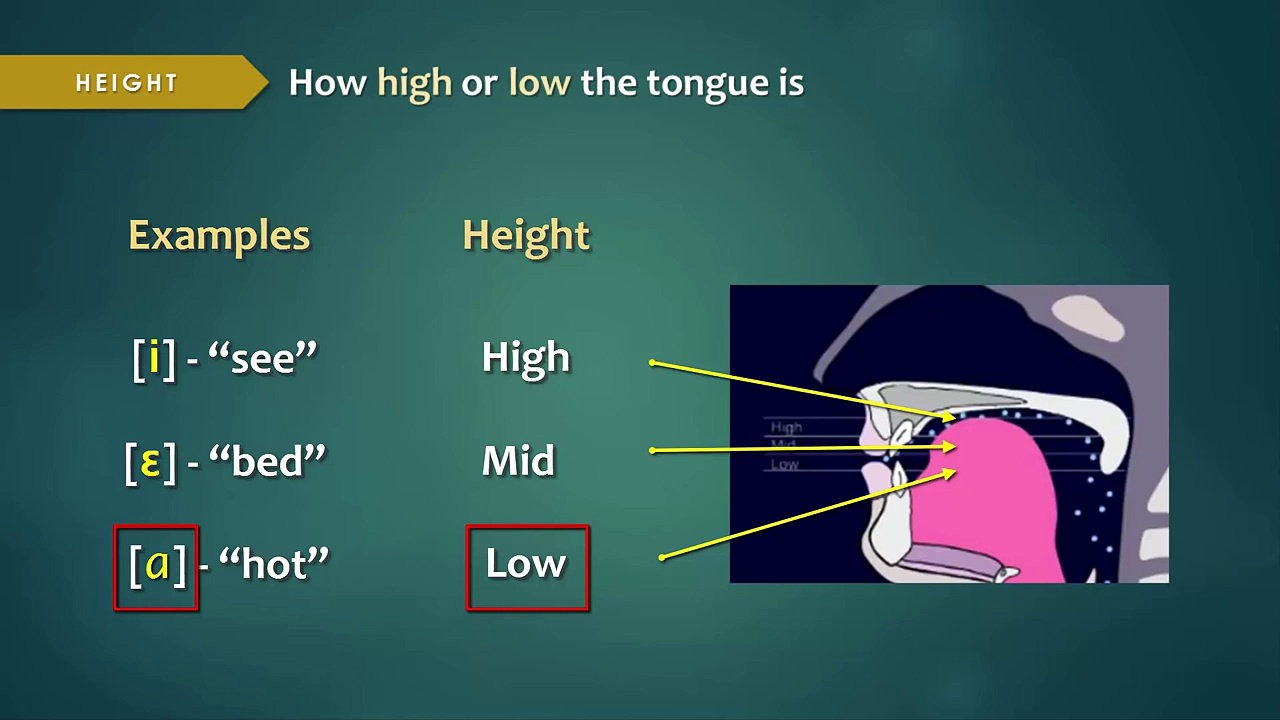
It refers to how high or low our tongue is. Thus we can say that /i/ is a high vowel sound, /e/ is intermediate, and /a/ is low. You may notice the movement of the tongue if you pronounce these three sounds.
Tongue Shape:

When we make a vowel sound, our tongue is in a specific position inside our mouth. For example, if you make the vowel sound /i/ and then /u/, you will notice that your tongue moves back, and if you make the sound /i/ and then /a/, your tongue moves down. The following chart shows the position of the tongue when we pronounce the English vowel sounds. You have to imagine that this chart is inside the mouth. For each sound, there is one phonetic symbol that belongs to the International Phonetic Alphabet.
Lip Rounding:

It refers to the position of our lips, when we make the vowel sounds. When we make the sound /i/, the corners of our mouth are further apart, so we can say that this is a spread vowel sound. When we pronounce /u/, our lips are rounded, and for the sound /a/ our lips are neither spread nor rounded, so we say that it is an unrounded vowel or neutral.
3.2. Short Vowels

/ʌ/ under, enough, butter
/i/ silly, baby
/e/ , want, cough edge, lead
/æ/ apple, man
/ʊ/ put, full
/ə/ above, support, possible, Africa, moth
3.3. Long Vowels
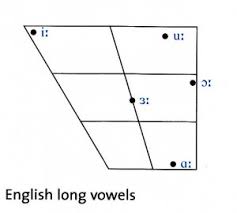
The five long vowels are different from the six short vowels described in Chapter 7, not only in length but also in quality. If we compare some similar pairs of long and short vowels, for example a with a:, or i with i: we can see distinct differences in quality (resulting from differences in tongue shape and position, and lip position) as well as in length. For this reason, all the long vowels have symbols which are different from those of short vowels; you can see that the long and short vowel symbols would still all be different from each other even if we omitted the length mark, so it is important to remember that the length mark is used not because it is essential but because it helps learners to remember the length difference.
i: (example words: 'beat', 'mean', 'peace') This vowel is nearer to cardinal vowel no. 1 [i] (i.e. it is closer and more front) than is the short vowel of 'bid', 'pin', 'fish' described in Chapter 7. Although the tongue shape is not much different from cardinal vowel no. 1, the lips are only slightly spread and this results in a rather different vowel quality.
3: (example words: 'bird', 'fern', 'purse') This is a mid-central vowel which is used in most English accents as a hesitation sound (written 'er'), but which many learners find difficult to copy. The lip position is neutral.
a: (example words: 'card', 'half, 'pass') This is an open vowel in the region of cardinal vowel no. 5 [a], but not as back as this. The lip position is neutral.
: (example words: 'board', 'torn', 'horse') The tongue height for this vowel is between cardinal vowel no. 6 [c] and no. 7 [o], and closer to the latter. This vowel is almost fully back and has quite strong lip-rounding.
U: (example words: 'food', 'soon', 'loose') The nearest cardinal vowel to this is no. 8 [u], but BBC u: is much less back and less close, while the lips are only moderately rounded.
3.4. Diphthongs

In terms of length, diphthongs are similar to the long vowels described above. Perhaps the most important thing to remember about all the diphthongs is that the first part is much longer and stronger than the second part; for example, most of the diphthong ai (as in the words 'eye', 'I') consists of the a vowel, and only in about the last quarter of the diphthong does the glide to I become noticeable. As the glide to i happens, the loudness of the sound decreases. As a result, the i part is shorter and quieter. Foreign learners should, therefore, always remember that the last part of English diphthongs must not be made too strongly.
3.5. Triphthongs
A triphthong is a glide from one vowel to another and the to a third, all produced rapidly and without interruption.
